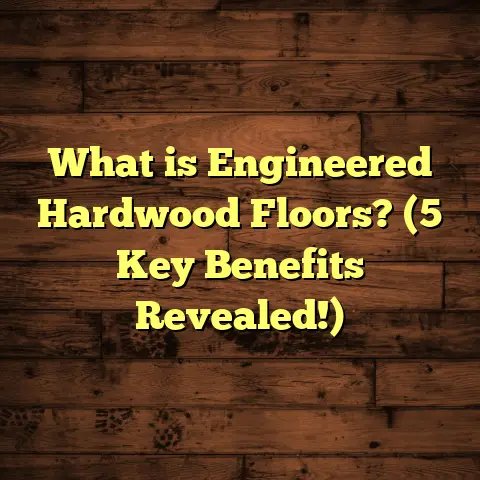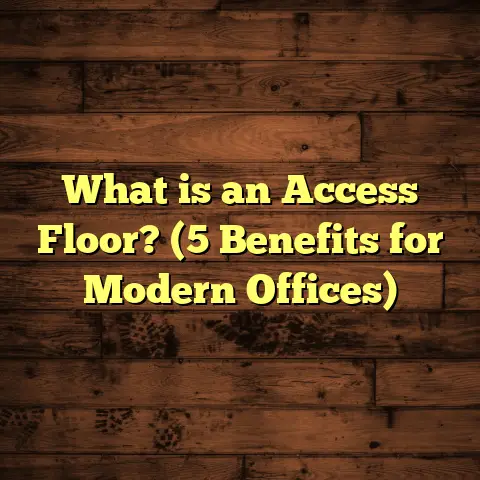What is an Engineered Wood Floor? (5 Benefits You Must Know)
I still remember the first time I stepped onto an engineered wood floor. It was in an old Victorian house renovation project I was working on early in my career. The smell of real wood, the warmth underfoot, and the way the light played off the grain—it felt like stepping into a story. I was captivated by how it combined the beauty of natural hardwood with a resilience that seemed almost futuristic compared to traditional floors I’d worked with before. That moment shaped how I think about flooring forever.
Over the years, I’ve installed countless engineered wood floors in different settings—from cozy family homes to large commercial spaces—and I’ve seen firsthand how this material can transform a space. If you’re curious about what makes engineered wood floors stand out, what benefits they bring, and whether they could be right for your home or project, stick with me. I’ll walk you through everything with straightforward language and plenty of examples.
What is an Engineered Wood Floor?
Let’s start by getting clear about what engineered wood flooring really is. You might have heard the term tossed around but wondered how it differs from solid hardwood or laminate.
At its simplest, an engineered wood floor is made up of multiple layers of wood that are glued together. The top layer is a thin slice of real hardwood—like oak, maple, cherry, or walnut—that gives you the authentic look and feel of wood because it is wood. The layers underneath, called the core or substrate, are typically made from plywood or high-density fiberboard (HDF). These layers are stacked with their grains running perpendicular to each other.
Why perpendicular grains? Because it adds strength and stability. This cross-layered construction makes engineered wood far less prone to expanding, shrinking, or warping when exposed to moisture and temperature changes compared to solid hardwood planks that are cut from a single piece of timber.
How Engineered Wood Is Made
Understanding the manufacturing process helps appreciate why engineered wood floors perform so well:
- Veneer Production: A thin slice of hardwood is peeled or sliced from a log. This veneer thickness varies but typically ranges between 0.6 mm to 6 mm.
- Core Layer Assembly: Multiple layers of plywood or HDF are stacked and glued with grain directions alternating—this is called cross-ply construction.
- Pressing: The layers are pressed together under heat and pressure to create a strong bond.
- Cutting Into Planks: The bonded boards are cut into flooring planks of standard sizes.
- Finishing: The wear layer gets sanded smooth and coated with protective finishes like aluminum oxide or polyurethane. Additional textures such as wire brushing or hand-scraping can be applied for design variety.
Thickness and Veneer Variations
The total thickness of engineered wood planks varies but generally falls between 3/8 inch (around 9 mm) and 3/4 inch (about 19 mm). The thickness of the hardwood veneer on top affects both durability and the possibility for refinishing later:
- Thin veneer (0.6 – 2 mm): Common in cheaper products and often not suitable for sanding.
- Medium veneer (2 – 4 mm): Can be sanded once or twice.
- Thick veneer (4 – 6 mm): Can be sanded multiple times like solid hardwood.
When I consult clients, I always emphasize checking the veneer thickness if they want a floor that lasts decades and can be refinished multiple times.
Five Benefits You Must Know About Engineered Wood Floors
1. Stability and Durability That Surprises You
One of the standout benefits I’ve witnessed repeatedly is how stable engineered wood floors are compared to solid hardwood. This stability comes from the multi-layered construction that counters natural wood’s tendency to expand and contract with humidity changes.
Wood naturally absorbs moisture from the air and swells; when dry, it shrinks back. This cycle can cause warping, cupping, or cracking in solid hardwood. Engineered wood’s cross-layer design restricts this movement dramatically.
Real Data To Back It Up
A study by the National Wood Flooring Association (NWFA) found that engineered wood flooring experiences roughly 70-80% less dimensional change than solid hardwood under fluctuating humidity conditions.
In practical terms, this means fewer gaps between boards in winter or less buckling during humid summers.
During one project in coastal Florida where humidity swings are common, a client had previously struggled with warped solid oak floors. After switching to engineered flooring with a thick oak veneer and plywood core, they reported zero issues after three years—even during hurricane season.
How This Affects You
If you live in a place with high humidity or temperature swings—like near the ocean or in regions with cold winters—engineered wood offers peace of mind that your floor will stay looking good longer without costly repairs.
2. Installation Made Easier—For Everyone
If you’re someone who enjoys DIY or wants to reduce labor costs on your project, engineered wood floors open up more options than solid hardwood.
Because engineered planks are dimensionally stable and can be thinner overall, they can be installed using several methods:
- Floating Floors: Planks snap together over a foam underlayment without any glue or nails.
- Glue-Down: Planks adhere directly to concrete or plywood subfloors.
- Nail-Down: Traditional method nailing into wooden subfloors.
- Staple-Down: Similar to nail-down but uses staples.
This flexibility is huge in my line of work because it allows adapting to different subfloor types. For example, concrete slabs often pose challenges for solid hardwood installation without expensive moisture barriers. Engineered wood can be glued directly to concrete with proper adhesives.
My Personal Experience With Installation
I once helped a client install engineered flooring over an existing vinyl sheet floor in their rental property. We used a floating click-lock system that required no adhesives or fasteners—a huge time-saver that kept costs down while delivering beautiful results.
For homeowners wanting a weekend project, floating engineered floors are often preferred because you don’t need specialized tools or contractors.
3. Affordable Elegance Without Sacrifices
When shopping for flooring, price is always a factor. Solid hardwood tends to be more expensive because you’re paying for thicker wood cuts, more intense milling, and higher waste during production.
Engineered wood floors often come at a lower price point while still giving you genuine hardwood on top.
Here’s a rough price comparison based on recent market data for mid-grade options including materials and professional installation:
| Flooring Type | Average Cost per Square Foot |
|---|---|
| Solid Hardwood | $8 – $14 |
| Engineered Wood | $6 – $12 |
| Laminate | $2 – $5 |
You can see engineered wood occupies a sweet spot—more affordable than solid hardwood but offering far superior aesthetics and lifespan compared to laminate or vinyl options.
This balance has made engineered flooring my go-to recommendation for clients looking for “real wood” appeal on a budget.
4. Environmental Impact That Makes Sense
I care deeply about sustainability—in fact, I’ve worked on many projects where clients asked me specifically about eco-friendly choices. Engineered wood floors often score better environmentally because they use less slow-growing hardwood per square foot.
By using a thin hardwood veneer instead of a full plank, we’re conserving precious timber resources. The core layers often come from faster-growing softwoods like pine or poplar or reclaimed wood fibers.
Many manufacturers also source their plywood cores from sustainably managed forests certified by organizations such as FSC (Forest Stewardship Council).
A report from the Hardwood Federation found using engineered wood flooring can reduce raw hardwood demand by up to 60% compared to solid hardwood for the same square footage installed.
This means less deforestation and lower carbon emissions overall—even factoring in manufacturing energy use.
Personal Take on Sustainability
I always encourage clients who want “green” flooring options to consider engineered wood plus finishes low in volatile organic compounds (VOCs). It’s a great way to combine durability with responsible sourcing.
5. Design Flexibility That Lets You Get Creative
One thing I love about engineered wood floors is how many design options exist now compared to even just five years ago.
Because the top veneer is real hardwood, you can choose from dozens of species:
- Traditional: Oak, maple, cherry
- Exotic: Brazilian walnut (Ipe), hickory
- Rare finds: White ash, teak
Each species offers unique grain patterns and colors.
Additionally, finishes vary widely:
- Smooth matte for modern spaces
- Hand-scraped or distressed for rustic charm
- Wire-brushed texture to highlight grain
You can also get wide-plank or narrow-strip styles depending on your room’s look and size.
In one project for a client who loved mid-century modern style, we installed wide-plank oak engineered flooring with a natural finish paired with minimalist furniture. The floor became the room’s centerpiece without overpowering it.
Diving Deeper: Technical Details and Maintenance Tips
How Durable Are Engineered Wood Floors Over Time?
Durability depends heavily on two factors: wear layer thickness and finish quality. Thicker veneers mean you can sand off scratches multiple times during refinishing.
Finishes like aluminum oxide coatings add scratch and stain resistance that help maintain beauty over many years.
From my experience working on homes ranging from new builds to historic renovations:
- Floors with veneers under 2 mm usually last 10-15 years before needing replacement.
- Veneers 3-6 mm thick can last 20+ years with periodic refinishing every 7–10 years.
- Proper maintenance extends life significantly.
Can You Refinish Engineered Wood Floors?
Yes—but only if the wear layer is thick enough. Always check this before buying if you want future sanding ability.
I had one client thrilled that their engineered oak floor could be sanded three times over 25 years—each time bringing fresh life back without replacing planks entirely.
Daily Care Tips
Keeping your floor looking great doesn’t require special treatments:
- Sweep or vacuum regularly to remove grit that scratches finishes.
- Use damp mop occasionally—avoid soaking water.
- Place felt pads under furniture legs.
- Clean spills immediately.
- Avoid harsh cleaners containing ammonia or bleach.
My Case Studies: Real Homes Using Engineered Wood Floors
Case Study 1: Coastal House Resisting Humidity
A homeowner in Charleston had ongoing problems with solid hardwood floors warping due to humidity swings near the oceanfront.
We installed engineered hickory flooring with a 4 mm veneer over plywood subflooring. After two years, there were zero signs of moisture damage despite frequent storms and high indoor humidity.
The client was thrilled with how natural yet durable their new floor felt.
Case Study 2: Basement Renovation That Works
Basements are tough spaces since moisture levels tend to be high and subfloors are often concrete slabs.
For a family finishing their basement rec room, we chose an engineered maple floor glued directly to the concrete using moisture-resistant adhesive. The result was warm underfoot without worries about swelling or mold growth common with solid hardwood.
Frequently Asked Questions You Might Have
Q: Can I install engineered wood over radiant heat?
Absolutely! Engineered flooring handles temperature changes better than solid hardwood, making it ideal over radiant heating systems. Just check manufacturer guidelines for max temperatures.
Q: How does it compare to laminate?
Laminate is synthetic with photographic layers mimicking wood grain but lacks real wood veneer. Engineered offers real wood beauty plus better longevity and refinish options.
Q: Is it noisy?
Floating installations may have slight “hollow” sound underfoot if not installed over proper underlayment. Using quality underlayments reduces noise significantly.
Wrapping Up My Thoughts
I’ve walked thousands of feet across engineered wood floors—from newly built condos to century-old homes—and each time I’m reminded why this material has become such a favorite among homeowners and pros alike.
It offers authentic beauty combined with stability, affordability, eco-friendliness, design variety, and easier installation than traditional hardwoods.
If you want a floor that feels like home from day one but will age gracefully through life’s ups and downs—engineered wood should definitely be on your radar.
Feel free to ask me anything about specific brands, installation methods, or maintenance routines—I’m here to help you get it right!





